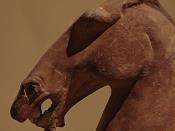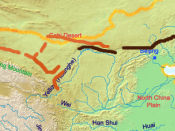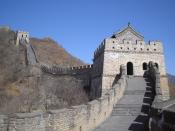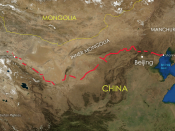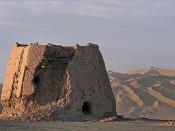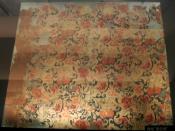During a dynastic cycle, China strives to unite as a country and find a new family to rule the state. The quest for gaining a bright and unmarked dynasty is a rough road. Finding a new family to gain the Mandate of Heaven, which is a political theory of those in power were given the right to rule from a divine source, requires them to build and rebuild ideas and theories from the previous dynasties. As a result, the new founded reign and its people begin to prosper. Major technological advancements, new art styles, and relationships are built between surrounding countries. For example, the Quin dynastyÃÂs contributed by making some of the first advancements in the highway system of China.
During time of prosperity, the population of China begins to grow. After a while, corruption begins to set in, and the dynasty from that point on begins the steady downfall into instability.
The QuinÃÂs control embarks on a short life due to the first administrationÃÂs strict policy. However, the laws became stricter as years went by and the idea to burn books surfaced. The Han dynasty lifted the harsh laws left over from the Quin, continued to work on the Silk Road and began to focus not on the Great Wall, but centering all attention to stabilizing the government.
Family after family began to rule China taking what did not work from one and tweaking the idea to make it work for another. Most dynasties enter a warring states period where two separate families decide to go to war for control over China. Likewise, the Yuan were a barbaric dynasty, and the first and only foreign rulers of China. At the founding of the Yuan, they had the strongest army in the world, but the duties that came with ruling new land stretched their control. A postal system was put into place along with rich development of literature and art. Still, Chinese nobility was not allowed to enter the governmental positions. Their decision had two downfalls: the Mongols treated foreigners better than the Chinese leading to many public uprisings. Also, by not allowing them into the governmental system and the Mongols had no knowledge of traditional Chinese rule. Losing their interest in controlling China, the Mongols were replaced by the Ming dynasty.
The Ming completed the great wall, but from the beginning corruption from within the government became a problem. Power struggles began for control of every aspect of rule. When someone came out victorious there was too much work to be done and they still had to rely on others. Money was also a big problem for the Ming. The biggest distribution of silver and paper currency occurred during this dynasty due to lack of knowledge of inflation, and money became almost worthless. This constant rise and fall of dynasties lasted for thousands of years, but the Chinese set a way in which a government should and should not be ruled.
McMahan, Elizabeth, Robert Funk, and Susan X. Day. Literature and the Writing Process. Upper Saddle River: Prentice Hall PTR, 2006. 188-99.
